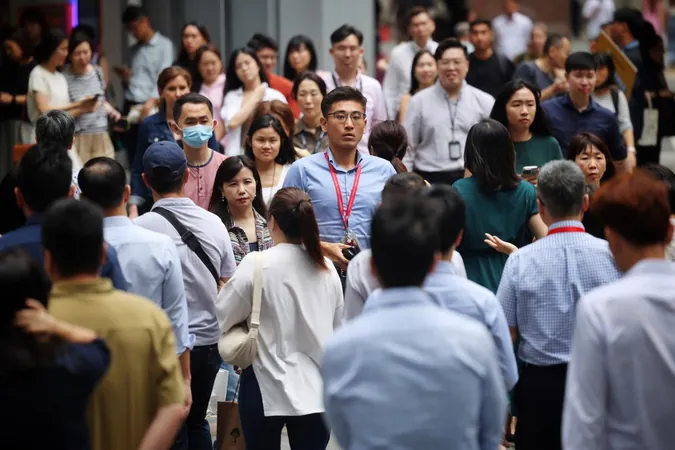
Employment Landscape in Singapore: A Promising Shift in 2024 Despite Increased Layoffs
2025-01-27
Author: Nur
SINGAPORE - The landscape of employment in Singapore witnessed noteworthy developments as the Ministry of Manpower (MOM) released preliminary data indicating a mixed but generally positive outlook for 2024. While layoffs surged in the final quarter of the year, the overall number of retrenchments for 2024 was less than the previous year, signifying a boost in resident employment levels.
Retrenchment Data and Trends
In the fourth quarter of 2024, retrenchments rose to 3,600, an increase from 3,050 in the preceding quarter. However, the total number of retrenchments across the year saw a decline to 12,930, down from 14,590 in 2023. Notably, corporate restructuring emerged as a prevalent reason for these layoffs, with key sectors like technology, e-commerce, and food and beverage (F&B) experiencing notable job cuts.
Sector-specific Insights
Economist Song Seng Wun from CGS International highlighted trends in the F&B sector, noting a slowdown in the opening of new businesses alongside an uptick in closures. This may be attributed to increased travel, with Singaporeans choosing to dine out less frequently domestically due to the strong Singapore dollar.
Resident Employment Gains
Despite the layoffs, the number of Singapore residents—comprising both citizens and permanent residents—gained employment in 2024. This marks a significant turnaround from 2023, which saw a decline in resident employment. However, the growth of foreign employment is expected to slow, contrasting with the previous year’s trends.
Overall Employment Growth
For the entire year, total employment growth is projected to be 45,500, notably lower than the 78,800 increase seen in 2023, except for foreign domestic workers. A more detailed analysis of employment growth will be provided in an upcoming report due in mid-March.
Quarterly Employment Changes
Examining quarterly growth figures, resident employment saw a decline to 8,700 in the fourth quarter, a sharp decrease from 22,300 in the previous quarter, though this still reflects an improvement from the mere 3,900 in the final quarter of 2023. Economists suggest that Singapore's employment growth is stabilizing as the local economy adjusts to a post-pandemic environment.
High-skilled Sector Trends
The job market has displayed positive trends in high-skilled sectors such as professional services, financial services, and health and social services, with retail trade also experiencing seasonally driven hiring spikes towards year end.
Foreign Employment Adjustments
Adjustments in foreign employment trends remain concentrated in the construction sector, yet there has been a decline in foreign roles within the information and communications and insurance services sectors. Meanwhile, the seasonally adjusted unemployment rate for Singaporeans slid slightly from 2.9 percent in October to stabilize at that level through December, remaining within the expected range for non-recessionary periods.
Looking Ahead: Employment Growth Challenges
Looking ahead, the MOM indicated that employment growth in 2025 may face challenges due to global uncertainties and economic volatility, but there are indications of optimism in the near term. A recent poll suggested an uptick in hiring sentiment, with 46 percent of companies expecting to expand their workforce, up from 43 percent earlier in the year.
Wage Increase Expectations
Additionally, 32 percent of employers signal intentions to raise wages, a significant increase from just 16 percent in September.
Outlook for 2025
Experts believe that despite potential risks from geopolitical tensions and trade issues, Singapore's employment landscape is on track for gradual expansion in 2025, with projected economic growth aligning with a medium-term potential rate of around 2 to 3 percent. Yet, the sustainability of this growth may largely hinge on global economic conditions.
Long-term Workforce Strategies
MOM emphasized the importance of employers recognizing the long-term constraints of an aging resident workforce and the necessity for increased foreign investments and talent to create more opportunities for local businesses and quality jobs for Singaporeans.
Maximizing Employee Potential
With the resident labor force participation rate already high by global standards and low unemployment rates, the focus moving forward should be on maximizing employee potential through investment in human capital development.
Stay tuned for more updates as we navigate the evolving employment landscape in Singapore!





 Brasil (PT)
Brasil (PT)
 Canada (EN)
Canada (EN)
 Chile (ES)
Chile (ES)
 Česko (CS)
Česko (CS)
 대한민국 (KO)
대한민국 (KO)
 España (ES)
España (ES)
 France (FR)
France (FR)
 Hong Kong (EN)
Hong Kong (EN)
 Italia (IT)
Italia (IT)
 日本 (JA)
日本 (JA)
 Magyarország (HU)
Magyarország (HU)
 Norge (NO)
Norge (NO)
 Polska (PL)
Polska (PL)
 Schweiz (DE)
Schweiz (DE)
 Singapore (EN)
Singapore (EN)
 Sverige (SV)
Sverige (SV)
 Suomi (FI)
Suomi (FI)
 Türkiye (TR)
Türkiye (TR)